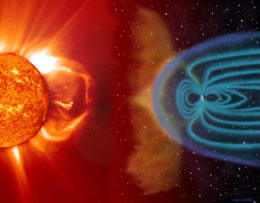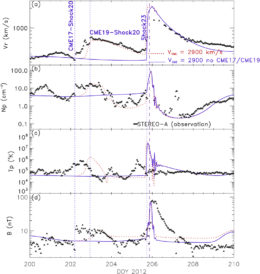The Sun launches tangled masses of plasma and magnetic fields in the form of coronal mass ejections. But these explosions don’t occur in a (literal or metaphorical) vacuum — how is the passage of a coronal mass ejection affected by the eruptions that preceded it?
Capturing Coronal Mass Ejections

Illustration of a coronal mass ejection headed toward Earth. [SOHO/LASCO/EIT (ESA & NASA)]
Given the risk of damaging effects on Earth-orbiting spacecraft, researchers have developed models to predict the path a coronal mass ejection will take after detaching from the Sun. These models estimate how a loop of magnetized plasma twists, expands, and is deflected as it travels through the tenuous swirls of the solar wind. However, many such models trade accuracy for speed in order to quickly assess the danger to Earth, failing to capture the variable and turbulent nature of the space between Sun and Earth, which may affect how coronal mass ejections travel through that space.
A Series of Solar Events
A team led by Chin-Chun Wu (Naval Research Laboratory) used magnetohydrodynamics simulations to explore how a coronal mass ejection moves through the wake left by previous solar eruptions. Wu and collaborators opted to model a series of five coronal mass ejections that occurred in two and a half weeks in July 2012, for which we have extensive data.

Modeled radial solar wind speed for four time periods. The red areas indicate coronal mass ejections. Click to enlarge. [Adapted from Wu et al. 2022; full time series available here]
Creating a Path to Follow

Observed (black points) and modeled (red and purple lines) plasma parameters. The model results for a series of three coronal mass ejections are shown as red dotted lines, and the model results for a single coronal mass ejection are shown in purple lines. From top to bottom, the parameters shown are the radial velocity (vr), the plasma density (np), the plasma temperature (Tp), and the magnetic field strength (B). Click to enlarge. [Wu et al. 2022]
Ultimately, the authors concluded that their model was able to match the observed parameters of the five coronal mass ejections fairly well. Their simulations allowed them to show that coronal mass ejections are affected by those that came before, suggesting that multiple events should be accounted for in modeling these eruptions.
Citation
“Magnetohydrodynamic Simulation of Multiple Coronal Mass Ejections: An Effect of Pre-events,'” Chin-Chun Wu et al 2022 ApJ 935 67. doi:10.3847/1538-4357/ac7f2a
